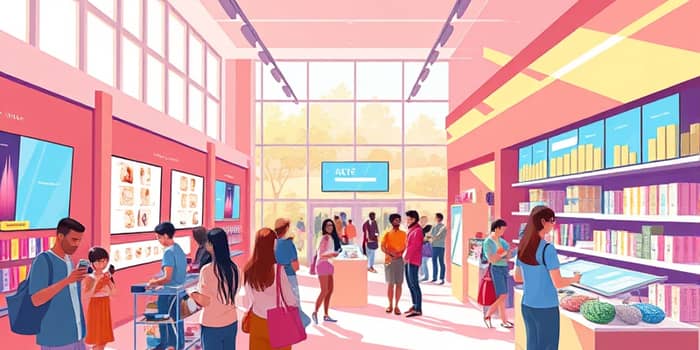
By 2025, the landscape of physical retail in the United States has reached a critical juncture. With a projected closure of 15,000 stores—almost double the 2024 total—the high street is undergoing a seismic shift. At the same time, retail giants such as Macy’s, CVS, and Foot Locker are leading this exodus, signaling profound change for communities and economies nationwide. Yet amid the uncertainty, opportunities for reinvention are emerging.
The year 2025 has seen the closure of roughly 15,000 retail stores across America, shattering previous records set during the COVID pandemic. Although 5,800 new locations are expected to open, this influx barely scratches the surface of losses witnessed on the high street. The cancellation of nearly 75,000 jobs in the first five months underscores an industry in turmoil. Beyond department stores, even pharmacies are thinning out, creating so-called “pharmacy deserts” in underserved areas.
Major players like Macy’s and Foot Locker have announced significant downsizing plans, while CVS and Walgreens shutter hundreds of outlets. These closures leave voids in urban centers and suburbs alike, eroding the vibrancy of main streets. As consumers increasingly migrate online, the physical footprint of traditional retail continues to contract at an unprecedented pace.
Several intertwined forces are accelerating the exodus from physical storefronts. First, the unstoppable growth in e-commerce has redefined shopping habits, pushing consumers toward digital platforms that offer unmatched convenience and selection. Global online sales topped $1 trillion in 2024, and digital channels now account for more than 21% of U.S. retail revenue, with no signs of slowing.
Second, landlords and operators are wrestling with persistent economic uncertainty looming over retailers. High commercial rents, rising wages, and unpredictable consumer confidence compel many chains to shutter underperforming branches to preserve margin. In tandem, the post-pandemic shift toward remote work and experiential spending siphons foot traffic away from traditional malls and shopping districts.
Third, consumers have developed heightened consumer expectations for speed and seamless service, benchmarked by tech-driven competitors. Same-day delivery, frictionless checkout, and personalized recommendations set a bar that many brick-and-mortar retailers struggle to reach. In this contest, differentiation often means investing heavily in infrastructure and talent, a challenge for those operating on razor-thin margins.
Amid a bleak outlook, there are glimmers of resilience. In-store sales globally are projected to reach $24.9 trillion in 2025, up 3.6% year over year. In the United States, brick-and-mortar outlets still represent over 84% of total retail sales, accounting for $1.46 trillion in Q1 2025 alone. Despite a slow decline in market share, physical stores continue to generate robust daily revenues.
Indeed, roughly 45% of American consumers primarily shop in-store, while 72% make a weekly visit to a retail outlet. Shoppers cite the tactile experience, immediate product access, and social interaction as key motivators for visiting physical locations. This enduring preference reveals that, even in a digital era, brick-and-mortar holds intrinsic value.
These figures highlight a fundamental tension: while digital channels boomed, the majority of retail transactions still occur face-to-face. Savvy retailers recognize this and are doubling down on the unique advantages of physical venues.
Furthermore, digital-native brands are leveraging interactive brand storytelling and community engagement to craft memorable in-store moments. Pop-up shops, limited-time activations, and local collaborations blend social media hype with face-to-face discovery, igniting both foot traffic and online chatter.
Retailers embracing change are focusing on immersive in-store advantages and personalized service. By curating interactive environments—such as product demonstrations, AR fitting rooms, and themed installations—brands can deliver experiences unmatched online. This not only drives foot traffic but also fosters emotional loyalty.
Many retailers are also adopting data-driven personalization and innovation, using advanced analytics to tailor offers, optimize inventory, and design store layouts that resonate with frequent customers.
Moreover, niche specialization is proving effective. Focusing on specialty merchandise and experiential retail allows companies to carve out defensible positions. Value-oriented formats and discount banners are also expanding, meeting consumer demand for affordable quality goods within a social shopping context.
The unraveling of the traditional retail sector carries consequences far beyond balance sheets. The loss of 75,000 jobs in a few months ripples through communities, impacting wages, benefits, and local tax revenues. In many towns, store closures translate directly into rising commercial vacancies and the erosion of downtown vibrancy.
Additionally, the proliferation of “pharmacy deserts” creates a public health concern. With hundreds of CVS and Walgreens outlets shutting doors, access to essential medications becomes uneven, particularly in rural and low-income urban neighborhoods. Although big-box pharmacies attempt to fill these voids, coverage gaps remain significant.
There is also a growing polarization between thriving and struggling retailers. Brands that invest strategically in technology, culture, and community partnerships are thriving, while those reliant on outdated models falter. This divide accelerates a broader realignment within retail, underscoring the need for agility and foresight.
As the industry stands at a crossroads, the choice is clear: succumb to the forces of decline or chart a path of reinvention. Retailers that leverage data-driven insights, prioritize customer centricity, and harness technology to bridge online and offline experiences will be best positioned for growth. The coming years will test the resilience of brands and the loyalty of consumers.
Ultimately, the fate of brick-and-mortar will be decided by retailers’ willingness to rethink space as a platform rather than a warehouse. When stores become stages for experience and hubs for real-time connection, they transform from mere outlets into destinations. This shift, powered by creativity and resilience, offers a hopeful vision for the future of physical retail.
References













